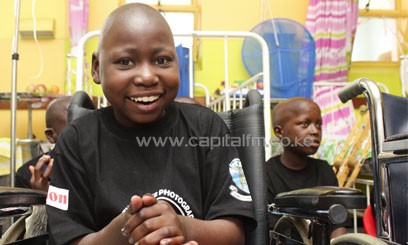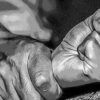Unlike other children their age – they’re between three and 13 – who are out playing in the sun, they wear black T-shirts with smiley faces and put on a show confined to their hospital ward.
The Kenyatta National Paediatric Cancer Ward to be specific: Ward 1E.
In the middle of song some of them have to be carried and laid on the cots that are lined up against the walls by the handful of nurses who tend to them; their strength waning.
Unlike hundreds of other children who are admitted to Kenyatta National Hospital with cancer related complications, these 28 fortunately, do not have to share a bed with two other children as those admitted in the general wards.
The bright yellow walls and Mickey Mouse portrait painted on one of them can get drab I imagine, if you have to stare at them for years; especially if you are a naturally inquisitive child.
The majority of these children have spent two to three years confined to the same space, an adjacent play room providing little distraction. One child, matron Noel Odera tells me, spent up to nine.
“They are lucky to be alive,” she says, “The time is a gift.”
Odera has worked in the paediatric ward for 10 years and lost too many children along the way.
Today they celebrate the culmination of a photography project dubbed ‘Keeping the Smile.’
Thirty-six children were given nine cameras to capture their time at the ward in February and 10 months later only half of that number has lived to see their pictures hang up on the walls outside their ward.
“This was my son,” Kangethe Mwangi says pointing at one of the pictures on the wall. It shows six year old Brian Mwangi holding up his T-shirt for a doctor to place his stethoscope; a woolly cap on his head.
He died three weeks ago following a two year battle with leukaemia.
“It started with a fever when he was four,” Kangethe tells, “he was first treated for malaria then typhoid. That was before they discovered there was a problem with his blood.”
“My wife had just given birth a week earlier and so it was I that stayed with him after he was admitted with my wife’s sisters bringing him fruits.”
“He needed blood but we had to wait four days to receive any. We wanted to donate but they said it would take time for the screening to take place.”
Eleven year old Meshack Baraza knows better than anyone how vital blood is. He too suffers from leukaemia. He has lived in Ward 1E for the last two years and hopes to go home soon.
He is strong enough now he tells me. He even led the other children in singing Father Abraham stomping and twirling in time to the chorus.
“He started bleeding from his nose and ears and his stomach was as hard as a rock,” Baraza’s father tells me, “that’s how we knew something was wrong.”
Joseph Macheme knew something was wrong as well when he felt something hard in his daughter’s stomach, “I thought she got hurt playing with her friends.”
Joseph’s daughter Naisula was later diagnosed as having a Wilms’ tumour; cancer of the kidney.
Naisula was a beautiful girl with a gap between her two front teeth but her father cannot look at the photo of her smiling face without his eyes watering; she died in September at six years of age.
Joseph is a broken man; his loss extending beyond that of the loss of his daughter.
“Each chemotherapy treatment costs about Sh45,000 and the medication is very strong. Every father would like his daughter to have long hair but the effects of the medication are brutal.”
His relationships too, Joseph confesses, suffered from the strain of his daughter’s illness, “Your brothers and sisters see your call and they automatically think you’re calling to ask for money.”
“You see many families fall apart,” Odera testifies, “the parents blame each other for being the cause of the cancer.”
“About two to three children with cancer are abandoned at the hospital every year because they lose their limbs or the parents simply cannot afford the medical care. A year here can cost up to Sh1 million.”
Mary Nanjale has no idea how she will pay her daughter’s medical bill but she is grateful her seven year old daughter Laramat is well and once discharged, she will be able to see her more than the two times she has in the last three years.
“We live in Samburu and I have three other children so my husband would be the one to visit Laramat before he died.”
Laramat’s cancer manifested with swelling and hardening of the stomach muscles. A sign she had a Wilms tumour, one of several cancers that occur mainly in children.
These cancers, haematologist Grace Kitony says, have recovery rates above eighty percent if caught in time.
“When you’re washing your baby make sure you check for any hardness in the kidneys. If you wash your child regularly, you should be able to detect the formation of an abnormal mass.”
“Cancer is not a death sentence,” Kitony says encouragingly but admits its treatment can take painstakingly long.
“There is a lot of pain associated with cancer; the pricking that comes with testing, the drugs that make you sick. It’s difficult to watch a child live through it.”
That being said, “God is good all the time even when there is pain,” the doctor believes.
The children’s raised voices echo her thoughts heralding hope in the midst of despair, “Father Abraham had many sons, I am one of them and so are you, so let us praise the Lord.”










































